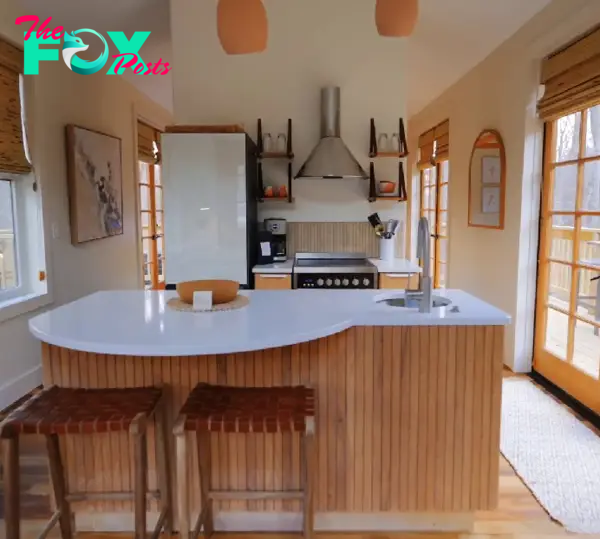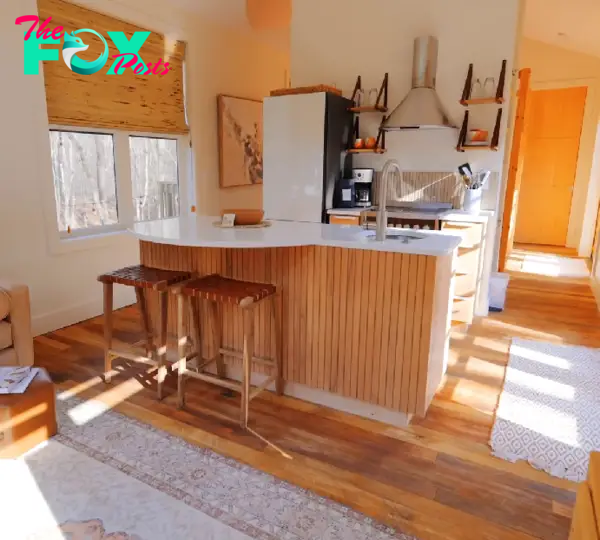Lifestyle
Man gives tour of 450-sq-foot cabin that looks simple on the outside but is “magical” inside

Nestled amidst the picturesque landscapes of Ohio’s enchanting Hocking Hills, a collection of charming tiny homes and vacation rentals beckon Travelers seeking a retreat into nature’s embrace.

In this idyllic region, where the splendor of the outdoors effortlessly enhances any dwelling, the GloCabin emerges as a distinctive gem, captivating visitors not only with its exterior allure but also with the surprises it holds within.

Contrasting against the verdant surroundings, the GloCabin’s dark Alderwood French doors and matte black facade may initially exude a hint of solemnity. However, this understated color palette serves as a striking canvas, allowing the cabin to make a bold statement amidst its natural backdrop.

Stepping into the GloCabin unveils a transformative experience. The somber exterior gives way to a luminous and welcoming interior, inspired by the laid-back elegance of California Casual design.

Within its cozy confines, neutral tones harmonize with warm wood accents, creating an ambiance of tranquility and comfort. Thoughtfully arranged common spaces encourage effortless interaction and movement, seamlessly connecting the living area with the well-appointed kitchen and breakfast counter.

Despite its compact footprint, the GloCabin offers ample space for relaxation and entertainment, with a thoughtful layout that maximizes functionality without compromising on comfort. Culinary enthusiasts will delight in the fully-equipped kitchen, complete with modern appliances and a stylish central island that doubles as a versatile dining spot.

The bedroom, accessible from both sides of the cabin, beckons with its cozy charm and generous storage options. Doors opening onto separate decks blur the boundaries between indoor and outdoor living, inviting guests to savor alfresco dining against a backdrop of awe-inspiring vistas.

The bathroom exudes an airy elegance, boasting a spacious shower and a vanity table crafted from reclaimed materials, infusing the space with a sense of history and character. A hidden gem awaits behind a second door, leading to a deck adorned with a luxurious Japanese Cedar Spa tub, a sanctuary for relaxation amidst the wilderness.

Designed to embrace the great outdoors, the GloCabin seamlessly integrates indoor comfort with outdoor adventure. Expansive decks offer panoramic views and direct access to hiking trails, catering to nature enthusiasts and leisure seekers alike.
In essence, the GloCabin transcends the limitations of its size, proving that true elegance knows no bounds. Whether indulging in moments of serenity or embarking on outdoor escapades, this charming abode promises an unforgettable retreat into the heart of nature’s splendor.
There’s One Method of Healing Trauma That Prince Harry Uses, and Here’s How to Practice It
Prince Harry recently opened up about his journey with post-traumatic stress disorder following the loss of his mother, Princess Diana. In a candid discussion, he revealed his exploration of a groundbreaking therapy that helped him.

The therapy is called eye movement desensitization and reprocessing (EMDR) to address the debilitating effects of his anxiety attacks. This revelation offers a glimpse into the royal’s personal struggles and his proactive approach towards mental Health care, shedding light on the significance of seeking innovative treatments of traumas.
In a video, Prince Harry can be seen undergoing EMDR therapy, where he taps his shoulders and moves his eyes rapidly. This therapy is relatively new and is used to treat PTSD. Prince Harry shared that he decided to try EMDR to deal with severe anxiety attacks he was experiencing.
Prince Harry mentioned that he was open to trying EMDR because of the therapy and work he had done over the years.

During a therapy session with UK-based psychotherapist Sanja Oakley, Prince Harry demonstrated how EMDR helped him feel better about returning home. He described feeling scared and helpless before, but the therapy helped him cope with those feelings.
Prince Harry’s openness about his experience with EMDR therapy sheds light on alternative treatments for post-traumatic disorder and mental Health struggles. It shows that seeking help and trying different therapies can make a difference in managing mental Health conditions.

EMDR is a therapy made in 1987 to help with emotional traumas. It’s a structured therapy where you think about a tough memory while moving your eyes back and forth. This helps lessen the strong feelings tied to the memory.
EMDR works on a theory called Adaptive Information Processing (AIP). It says that trauma sticks around because it hasn’t been dealt with properly. So, when something reminds you of the trauma, those memories can come back strongly.
Unlike other therapies that try to lessen your reaction to trauma, EMDR tries to change how your brain stores those tough memories. Sometimes, instead of eye movements, you might listen to alternating tones. Usually, EMDR happens once or twice a week for about six to 12 sessions. But it can vary depending on the person.
Benefits of EMDR therapy
- EMDR is a structured therapy and usually needs fewer sessions than ongoing therapies.
- You don’t have to keep going back to the tough memory for a long time.
- You don’t have to talk a lot about what happened to you.
- There’s no homework to do.
- EMDR doesn’t try to change your thoughts and beliefs.
Disadvantages of EMDR therapy
- While EMDR is known to help with PTSD, it hasn’t been studied as much for other mood or mental health problems.
- If you’re avoiding talking about a tough event, EMDR might not be the best choice. Other types of talk therapy might work better.
- EMDR can sometimes make you feel worse at the start of treatment. The person who created EMDR warns that this could be dangerous for people who have gone through really tough things.
The process of EMDR
EMDR is a structured process with eight phases, each aimed at helping you deal with traumatic memories:
- History taking: Discuss your past with the therapist to identify which memories to focus on.
- Preparation: Learn about EMDR and how the therapist will use bilateral stimulation.
- Assessment: Identify your negative and positive beliefs related to the trauma.
- Desensitization: Use bilateral stimulation while recalling the memory.
- Installation: Focus on positive beliefs while processing the memory.
- Body scan: Talk about how you feel emotionally and physically.
- Closure: Prepare for what may happen between sessions.
- Reevaluation: Assess your progress and decide if more sessions are needed.
As you go through EMDR, you may start feeling less overwhelmed by the trauma. It’s normal for other painful memories to surface, indicating that suppressed memories are being processed.
When grappling with deep emotional traumas, it’s crucial to seek out specialists who can provide the appropriate form of treatment tailored to your needs. Whether it’s EMDR therapy or other therapeutic approaches, finding the right professional can make a significant difference in your healing journey.
Preview photo credit Good Morning America / YouTube
-

 Lifestyle3h ago
Lifestyle3h agoArnault Family: Get to Know the Billionaire Heirs of Bernard Arnault and Their Top Positions at LVMH
-

 Lifestyle4h ago
Lifestyle4h agoGazans turn to pottery amid shortages | The Express Tribune
-

 Lifestyle4h ago
Lifestyle4h agoBlasts at rapper Badshah's club tied to Bishnoi gang | The Express Tribune
-

 Lifestyle9h ago
Lifestyle9h agoGladiator II' makes $106M in global box office | The Express Tribune
-

 Lifestyle9h ago
Lifestyle9h agoA journey through the kitchen | The Express Tribune
-

 Lifestyle12h ago
Lifestyle12h agoHow We Chose TIME’s 2024 Kid of the Year
-

 Lifestyle13h ago
Lifestyle13h agoF1 NEWS: Hamilton Shows NO MERCY Towards Mercedes & Wolff After SABOTAGED Las Vegas GP!.cau
-

 Lifestyle14h ago
Lifestyle14h agoJin steps out of the BTS hive with 'Happy' | The Express Tribune

















